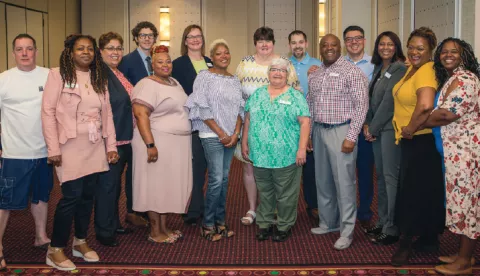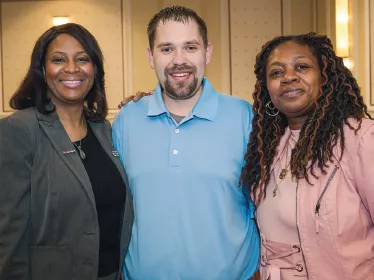Most educators know that professional development opportunities designed specifically for education support professionals (ESPs) are hard to find. When they do exist the programs are often irrelevant. As a result, most ESPs often provide themselves with the career learning opportunities they need.
“Everyone thinks professional development is for teachers only,” says Matthew Powell, custodial supervisor at Central Elementary School in Mayfield, Ky. “But ESPs also need the opportunity to learn.”
After three years as a special education paraeducator, Powell returned to college to complete a bachelor’s degree in educational studies. To make ends meet, he worked nights as a school custodian.
A member of NEA’s ESP Careers Committee, Powell works alongside ESPs and teachers from across the country to increase professional learning opportunities for school support professionals. The committee is most known for developing the innovative ESP Professional Growth Continuum (PGC), which centers on eight universal standards that provide a pathway for professional and personal growth for ESPs throughout their careers. “At the end of the day, if ESPs increase their skills and knowledge, it’s students who ultimately win,” says Powell, who was recently named the 2019 NEA ESP of the Year.
Universal Standards
The Professional Growth Continuum is a first-of-its-kind system grounded in the following universal standards: communication, cultural competence, organization, reporting, ethics, technology, professionalism, and health and safety.
Each standard contains three levels of practice: foundational, proficient, and advanced/mastery.
“You start by identifying your career family,” says Powell. “Then, select one of the eight universal standards you want to focus on.”
This resource is applicable across NEA’s nine ESP job categories:
- Clerical Services
- Custodial/Maintenance Services
- Food Services
- Health and Student Services
- Paraeducators
- Security Services
- Skilled Trades
- Technical Services
- Transportation Services
Powell suggests that ESPs read through the three levels of practice under each standard and determine what they want to focus on relative to how they want to develop personally and professionally.
“ESPs can use the indicators and descriptors listed under each level to identify their level of proficiency within that standard,” he says.
Next comes the selection of micro-credentials, which are short, competency-based recognitions that allow educators to demonstrate mastery in a particular area.
By completing micro-credentials, ESPs can learn how to use the standards to demonstrate their current skill levels and map out opportunities at school that help them grow.

Becoming Your Best
Participants can work independently or join a professional learning community. Several NEA affiliates across the country work with members and other education leaders to develop student-centered learning opportunities aligned with the PGC.
“It goes back to wanting to be the best we can be for our students,” says Powell, who helps implement PGC standards for custodian and maintenance service workers at Grave County Schools.
The continuum model is structured to reflect the current skill levels of an ESP while providing a path to attaining further knowledge and mastery as indicated within the eight standards.
For example, an ESP might be proficient in one standard, like communications, where they write reports that are grammatically correct, but advanced in another, such as cultural competence. An ESP who is advanced in cultural competence can identify and address the consequences of inequities based on racial, socioeconomic, gender, disability, or other aspects of identity. Additionally, that ESP can comfortably lead racial justice and equity discussions.
"Everyone thinks professional development is for teachers only. But ESPs also need the opportunity to learn and grow in their careers."
— Matthew Powell, Custodial Supervisor, Central Elementary School, Mayfield, KY
Cultural Competency
In New Jersey, Kimberly Scott- Hayden led the development of trainings for East Orange Maintenance Association (EOMA) members using PGC standards. The program started after Scott-Hayden, an inventory control clerk specialist and NEA board member, contacted Superintendent Kevin West of the East Orange School District.
“Before anything, you need to effectively communicate a message, a perception, or a theory,” says Scott- Hayden, who first convinced West with the idea of training ESPs to communicate more effectively at work.
EOMA’s original 32 members were the first to join the PGC training sessions. Scott-Hayden and West began by presenting them with the question: How can I grow professionally to become more culturally aware in communicating with students and colleagues?
Scott-Hayden and the team found that discussing culturally sensitive issues can be difficult. For example, participants discussed how they collaborate with members from culturally diverse groups, and how they evaluate their ability to recognize reactions in individuals different from themselves.
“Understanding the culture of your community gives you a better sense of your students,” says Andrea Beeman, a paraeducator who serves with Powell and Scott-Hayden on the NEA board and ESP Careers Committee.
Once educators saw the passion of Scott-Hayden and her team, the New Jersey program quickly expanded across East Orange. In 2018, the team was awarded one of NEA’s Great Public Schools Fund Grants for $90,000 over three years.
Almost immediately, the local experienced a spike in membership. There are now 370 members,
which includes teacher assistants, paraprofessionals, and security guards along with the maintenance workers.
“Based on the work they are seeing, people have said, ‘I’m buying into this.’ It builds capacity,” says Scott- Hayden. “It gives you an opportunity to show your district that you are an important stakeholder in your career development.”
She says locals can use PGC as leverage to increase salaries and for career advancement.
Students at the Center
Andrea Beeman, who teaches in Ohio, says trainings aligned to the PGC can help close the student achievement gap.
“In order to do my job effectively, I have to know a student’s strengths, weaknesses, interests, hopes, and dreams,” says Beeman, based at Maple Heights High School in Maple Heights.
Along with opportunities for professional growth offered by PGC is the chance to better connect with students, Beeman explains.
“As educators progress through the levels of practice, increased knowledge and skills are going to help them when they engage in difficult cultural conversations with students.”

